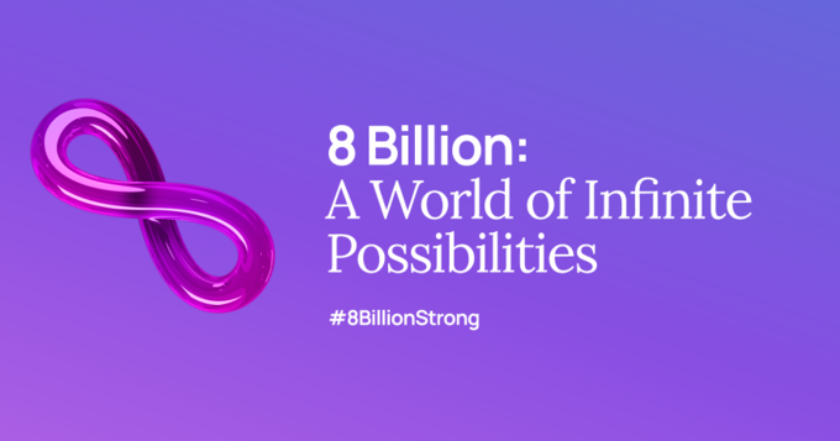World's population hits 8 billion people, UN calls for solidarity in advancing sustainable development for all

As the world population reaches 8 billion people, the UN calls for solidarity in promoting sustainable development for all
New York, November 15, 2022.
The world population is expected to reach 8 billion on November 15, 2022, reflecting significant improvements in health care that have reduced the risk of death and increased life expectancy. But the moment is also a clarion call to humanity to look beyond the numbers and fulfill our shared responsibility to protect people and the planet, starting with the most vulnerable.
UN Secretary-General Antonio Guterres said: "If we don't close the huge gap between rich and poor, we will create a world of 8 billion people filled with tension and mistrust, crisis and conflict."
A more demographically diverse world than ever before
Although the world's population will continue to grow to about 10.4 billion in the 2080s, the overall growth rate is slowing. The world is more demographically diverse than ever, with countries facing oppositely different population trends, ranging from growth to decline. Today, two-thirds of the world's population lives in low-fertility conditions, where lifetime fertility is less than 2.1 births per woman. At the same time, population growth is increasingly concentrated in the world's poorest countries, most of which are located in sub-Saharan Africa.
Against this background, the world community must ensure that all countries, whether their populations are growing or shrinking, are able to provide an adequate quality of life for their populations and can uplift and empower their most marginalized populations.
UNFPA Executive Director Dr. Natalia Kanem said: "A world of 8 billion people is an important milestone for humanity — the result of longer life expectancy, reduced poverty, and lower maternal and child mortality. However, focusing only on the numbers distracts us from the real challenge we face: to create a world in which progress can be achieved equally and sustainably."
"We cannot rely on one-size-fits-all solutions in a world where the median age is 41 in Europe compared to 17 in sub-Saharan Africa. To succeed, all demographic policies must be rooted in reproductive rights, investing in people and the planet, and be based on reliable data".
Complex links between population, sustainable development, and climate change
While the 8 Billion Day is a human success story, it also raises concerns about the links between population growth, poverty, climate change, and achieving Sustainable Development Goals. The relationship between population growth and sustainable development is complex.
Rapid population growth makes it difficult to eradicate poverty, fight hunger and malnutrition, and expand the reach of health and education systems. Conversely, achieving the SDGs, especially those related to health, education, and gender equality, will contribute to slowing global population growth.
Slower population growth, if sustained over several decades, could help mitigate environmental degradation; linking population growth to increased greenhouse gas emissions ignores that countries with the highest consumption and emissions are those where population growth is already slow or even negative. Meanwhile, most of the world's population growth is concentrated in the poorest countries, which have much lower emissions but are likely to be disproportionately affected by the effects of climate change.
"We must accelerate our efforts to achieve the goals of the Paris Agreement and the SDGs," said Li Junhua, UN Under-Secretary-General for Economic and Social Affairs. "We need a rapid decoupling of economic activity from the current over-reliance on fossil fuels, as well as increased efficiency in the use of these resources, and we must make this transition a fair and inclusive one that supports those left behind."
The need for a sustainable future based on rights and choices
To create a world where all 8 billion people can thrive, we must seek proven and practical solutions to mitigate our world's challenges and achieve the SDGs by prioritizing human rights. Finding these solutions requires additional investment by Member States and donor governments in policies and programs that aim to make the world safer, more sustainable, and more inclusive.
A quick overview of key facts and figures
- It took about 12 years for the world's population to grow from 7 to 8 billion, but the next billion is expected to take about 14.5 years (2037), reflecting a slowdown in global growth. The world population is projected to peak at 10.4 billion people during the 2080s and remain at that level until 2100.
- For the increase from 7 to 8 billion, about 70 percent of the added population was in low- and lower-middle-income countries. Growing from 8 to 9 billion, these two groups of countries are expected to account for more than 90 percent of global growth.
- Between now and 2050, the global increase in the under-65 population will occur exclusively in low-income and lower-middle-income countries, as population growth in high-income and upper-middle-income countries will occur only among those aged 65 or older.




















































